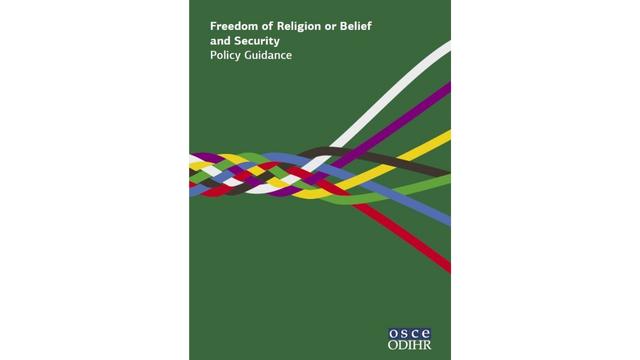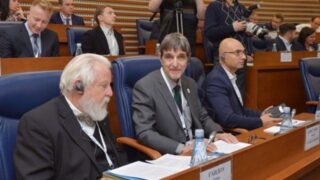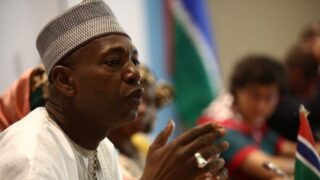Or perhaps they don’t hate anybody. They simply know that lurid tales connecting religion with money, power, and illicit sex always sell.
by Massimo Introvigne


The year was 1997. Italy was in the middle of violent media campaigns against “cults,” fueled by organized anti-cult movements. A previously unknown organization devoted to fighting “cults,” called “Cosamo,” started issuing press releases claiming that they had the best evidence of “cultic” crimes. They sent to different local media portions of a video with parts of a “ritual,” where “cultists” were ostensibly molesting young girls. Eventually, this generated a national interest, and one of the main Italian TV networks stated it would be prepared to broadcast the full video, if Cosamo would provide it. The mysterious Cosamo, which only communicated by leaving messages in mailboxes, answered that they could not supply the video, but had the technical means to provide a live feed. Of course, the network would be free to stop the live program at any time, should the images appear as too crude for broadcasting.
Eventually, the network accepted the conditions of Cosamo, and the sensational video appeared during a national TV program. In the video, masked “cultists” surrounded a bound and gagged young girl, ostensibly ready to molest and perhaps even kill her. When the audience was prepared for the worst, however, before the network managed to interrupt the broadcasting, the girl rose and started dancing with the “cultists,” and singing a song deriding the gullibility of the media.
The anti-cult organization Cosamo did not exist. As it came out, the whole story was an elaborated hoax by a group that called itself “Luther Blissett” (the name came from a famously inept soccer player). It had already become famous for its pranks exposing how credulous the media were. Of course, the prank itself became headline news, and Italian media wrote they had learned their lesson and will be more cautious in the future in believing sensational accusations against “cults.” Unfortunately, they quickly forgot both the incident and the lesson.
In 2018, American scholar W. Michael Ashcraft published what became the standard academic manual about the history of the study of new religious movements. Ashcraft described the development of the academic subfield, which had largely coalesced since the 1980s around the ideas that “cult” was not a valid category but a label used to slander unpopular minorities, “brainwashing” was a pseudo-scientific theory weaponized for the same purpose, and accounts by apostate ex-members—i.e., the minority among former members who had turned into militant opponents of the religions they had left—should be handled with care, and cannot serve as the main source of information about their former movements.
Ashcraft noted that an overwhelming majority of scholars of new religious movements agreed with these ideas, while a tiny minority seceded from the mainline, supported the militant anti-cult movements and the apostates, and created a separated group of “cultic studies,” which maintained that “cults” were different from legitimate religious and used “brainwashing.” “Cultic studies,” Ashcraft wrote, were never accepted as “mainstream scholarship.” They continued as “a project shared by a small cadre of committed scholars” but not endorsed by “the larger academic community, nationally and internationally.” “Cultic studies” scholars live in their own bubble, and only rarely appear in mainline conferences about new religious movements or are published in the corresponding journals.


Ashcraft, however, hinted at a peculiar phenomenon worthy of academic investigation in itself. While they represent a tiny and criticized minority in the academia, “cultic studies” scholars are quoted by the media as “experts on cults” more often than their mainline colleagues. More generally, militant anti-cultists and apostate ex-members play a disproportionate role as sources of media accounts about groups labeled as “cults.” Mainstream scholars are often ignored, as are those members who remain in religious movements and are happy about it. It also often happens that representatives of “cults” are called by reporters who are about to publish a negative article, asked abruptly “How do you defend yourselves?” and requested to provide a statement within a few hours, which is obviously a caricature of balanced journalism.
There are innumerable examples of this attitude. A spectacular one is the recent podcast series by the British The Telegraph on Jehovah’s Witnesses and sexual abuse. The podcast includes less than thirty seconds where Zoe Knox, a well-known scholar, shortly refers to some beliefs of the Jehovah’s Witnesses. After the very short guest appearance of Knox, the narrator expresses The Telegraph’s beliefs that “Aside from academics, the people who are really experts on this are those who’ve lived it: former Jehovah’s Witnesses.” By “former Jehovah’s Witnesses” The Telegraph means the apostates.
My criticism of The Telegraph’s series was discussed in an online forum of scholars who study the Jehovah’s Witnesses. George Chryssides, undoubtedly the leading British academic scholar of the Jehovah’s Witnesses, revealed that he had been interviewed at length by The Telegraph, but not a single word of his interview made it to the podcast. Simply, he had not told them what they wanted to hear.
The same Jehovah’s Witnesses managed to have an Italian publication (L’Indro) and two Norwegian ones (Fosna-Folket and Vårt Land) censored by the boards overseeing journalistic integrity, but this was too little too late. Lawyers know that defamation lawsuits are notoriously difficult. They also take years, and even a favorable decision coming when the original article has already produced its slandering effects is not of much use.
The 2019 OSCE (Organization for Security and Cooperation in Europe) “Policy Guidance” on freedom of religion or belief and security does reveal an awareness of this problem. It asks media “to make every effort to increase respect for religious and belief diversity by conveying unbiased and accurate information and representations of different religions and beliefs, and countering negative stereotypes and prejudices.” “By sharing positive narratives about all religious or belief communities, the OSCE said, and avoiding negative and discriminatory stereotypes, the media can contribute to a more tolerant societal discourse that is rooted in real life experiences of individuals and communities, without ignoring the challenges that exist. Indeed, the media are a key stakeholder in the development of a critical public discourse on coexistence among peoples of different religions or beliefs.”


It never happened. If anything, media bias against “cults” became worse. Why? There is not a single answer. Obviously, there are powerful anti-cult lobbies, often supported by governments that should justify their repressive policies, and they are more rich, powerful, and well-organized than scholars. More broadly, since the time of the anti-Catholic gazettes of the French Revolution, lurid tales about religion always sell, the more so when spiced with stories, true or false, of sexual abuse and money accumulated by greedy religionists. Power, money, and sex sell well by definition. It is a general problem of a media system governed by shares and sales rather than objectivity and truth. That a priest or pastor abuses young boys sells. That he sincerely devotes his life to the welfare and education of children doesn’t.
Reforming the media system is either impossible or a long-term project. Religious movements unfairly labeled as “cults,” and academics aware that most accusations against them are false, should of course react. However, they would do well in re-reading the “The Art of Being Right,” a surprisingly modern text German philosopher Arthur Schopenhauer wrote in 1831. As if anticipating modern media, Schopenhauer listed a series of gimmicks used to make a fake theory prevail. Fake information is spread by playing on existing prejudices of the readers, and counting on the fact few would read a denial.
An old newsroom joke is that “publishing a denial is publishing the same news twice.” In fact, simply denying an accusation never works. “We do not abuse children” simply confirms in the audience the idea that you have something to do with the abuse of children. As Schopenhauer taught, the argument should be truly reversed, without being defensive only, and moving the discourse on who the accusers are, what are their motivations, who we are, why in fact it is us who occupy a higher moral ground. A difficult strategy, but then media wars have never been won easily.









